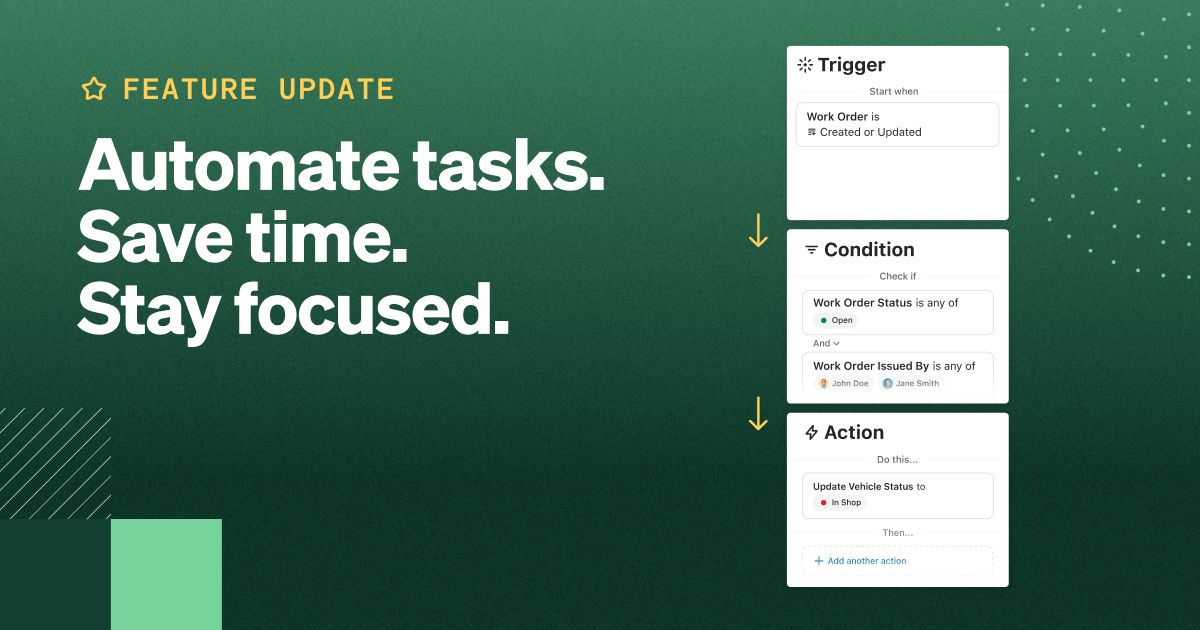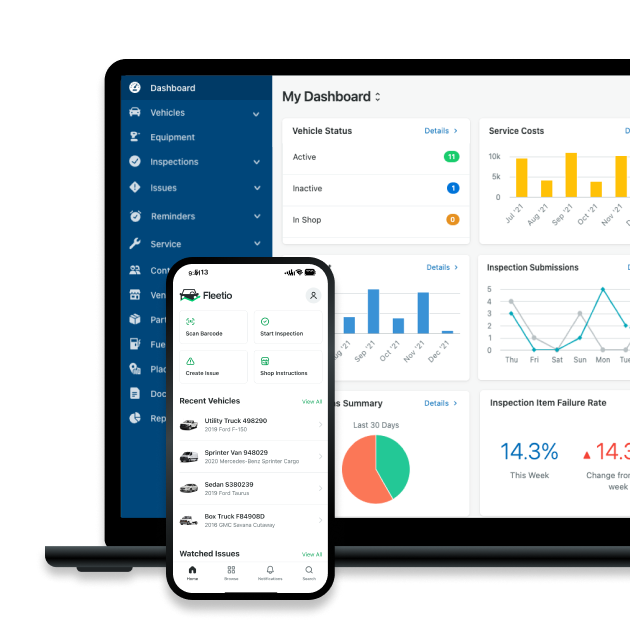How Fleets are Automating Workflows with Fleetio
In just six weeks since its beta release, real fleets have run over 73,000 automations using Fleetio – saving an average of 12.5 hours a month. From public works departments to regional carriers, teams are using workflow automation to cut down manual tasks, ensure accurate records, and stay focused on what matters.
Apr 24, 2025
6 min read
Content Overview
This blog introduces Fleetio’s automation workflow and shows how real fleets—who’ve already saved 12.5 hours per month on average—use it to eliminate manual tasks. It breaks down core components (triggers, conditions, actions) and highlights real customer examples, from trucking companies to municipal fleets. Learn how automations have powered over 73,000 updates since launch and why more teams are relying on them to improve visibility and accuracy across their operations.
What is workflow automation in Fleetio?
An automation is an instruction you can give Fleetio to automatically update your records when a specified event happens. If you're familiar with if-then statements, then you've already got the gist of how workflow automations behave.
Automations consist of three elements—triggers, conditions and actions:
- Triggers are events that initiate automations. They can be anything from a work order being created to an issue getting reported.
- Conditions allow you to get granular by stipulating details that need to be met in order for an automation to run. For example, if you want something to happen when a work order is created by a specific employee, you can set up a condition to enable that process.
- Actions are tasks that Fleetio automatically carries out when a trigger occurs and all associated conditions are met. Updating vehicle and work order statuses are two of the most-common automations fleets are using.
Put simply, if an automation's trigger occurs (and all its conditions are met), then its action will automatically be performed.
What kinds of tasks can you automate?
To help organizations streamline as much of their operations as possible, automations cover several key aspects of fleet management:
- Work orders: When an issue is resolved, when labor gets added or when parts you've been waiting on arrive, you can have Fleetio automatically update relevant work orders.
- Vehicle statuses: To maximize visibility over your vehicles, automations can automatically update vehicle statuses when work orders are created/completed or when an issue is reported.
- Vehicle/equipment issues: Based on rules you specify, you can configure Fleetio to automatically update the statuses of open issues and even create issues for specific locations.
- Shop and labor management: To keep your maintenance and repair records accurate and up-to-date, automations can auto-assign work orders to specific users and streamline offsite repairs.
See it in action
Automations were built to help you improve the accuracy of the fleet data you rely on. Schedule a demo with one of our product experts to get a personal walkthrough of this new feature.
How real fleets use automation
While automations just officially debuted in Fleetio, several fleets have already been testing this feature in our beta program. In the six weeks since its beta release, we've already seen more than 73,000 successful automations, with each fleet saving 12.5 hours a month on average.
Intra City Dispatch: Improving asset visibility
Intra City Dispatch's Automated Workflow
If a work order is created for an asset, then Fleetio automatically updates the asset’s status to “in the shop.”
Intra City Dispatch is a Michigan-based trucking and brokerage company. Its technicians do an admirable job of keeping the company's tractor-trailers, straight trucks and cargo vans in working order, but they aren't perfect when it comes to updating the statuses of those vehicles. Sometimes, they'll create a work order but forget to mark its associated vehicle as being in the shop. And, in the past, that would lead to confusing discrepancies between what was being displayed in Fleetio and reality.
But ever since they set up an automation that automatically updates the status of a vehicle when a work order for it gets created, Intra City Dispatch has been able to dramatically improve their data accuracy.
As soon as a work order has started, boom, [the vehicle is] listed as being in the shop. I don't have to worry about somebody going "Is that truck in the shop today?"
Like when a truck stops just to get windshield wipers. Those kinds of mini maintenance things get missed as "in the shop"/"out of the shop" things.
This being automated, we don't have to worry about it. We can see every time a truck stops to get something done on it. Jennifer Lamkin, Maintenance Controller
Now, Intra City Dispatch's fleet manager spends far less time identifying and correcting vehicle status errors. Plus, greater data accuracy enables ICD's maintenance controller to leverage vehicle histories more effectively when she sleuths for missing parts.
City of Farmers Branch: Proving value with better data
City of Farmers Branch's Automated Workflow
If a technician starts a work order, then Fleetio automatically updates the asset’s status to reflect its shop time—helping track vehicle uptime in real time.
From dump trucks to fire engines, the city of Farmers Branch, Texas relies on a typical lineup of public works and emergency vehicles to provide services to its 42,000 residents. Because these services are indispensable to the well-being of its inhabitants, maximizing vehicle uptime has always been a top priority of Fleet Operations Manager Kevin Reinartz.
Unfortunately, for a long time, tracking uptime of municipal vehicles was far from easy for Kevin.
Before this workflow automation, I had been harping on my [technicians] about updating the statuses of the vehicles as they came in and out of the shop. We were doing it on the work order side, but we weren't doing it on the asset side.
So I was missing that piece of an easy way to track vehicle uptime, which is one of my critical KPIs. Kevin Reinartz, Fleet Operations Manager
Now though, thanks to automations, Fleetio ensures that vehicle statuses are kept up-to-date. This improvement in data accuracy not only gives Kevin greater visibility over the health of his fleet and the productivity of his technicians, but it also helps him advocate more effectively for his fleet’s needs.
As a municipal fleet manager, the budget Kevin gets to work with is determined by Farmers Branch's city council. Fleetio provides Kevin with statistics he presents to the city council that prove his competency as a fleet manager and illustrate what his operations require to continue to function effectively. And the more insights about his operations Fleetio can provide (enabled by features like automations), the more angles Kevin has to make his case.
Take this feature for a test drive
Automations were built to make your day-to-day smoother and your operations stronger. Talk to a Fleetio product expert and see how they fit into your organization's workflow.
Talk to an Expert
Fleet Content Specialist
Through interviews, blog posts and webinars, Alex covers the tactics and technologies exceptional fleet managers use to achieve results. By sharing their success stories, his work aims to inform and inspire fleet professionals of all stripes.
LinkedIn|View articles by Alex BorgReady to get started?
Join thousands of satisfied customers using Fleetio
Questions? Call us at 1-800-975-5304

